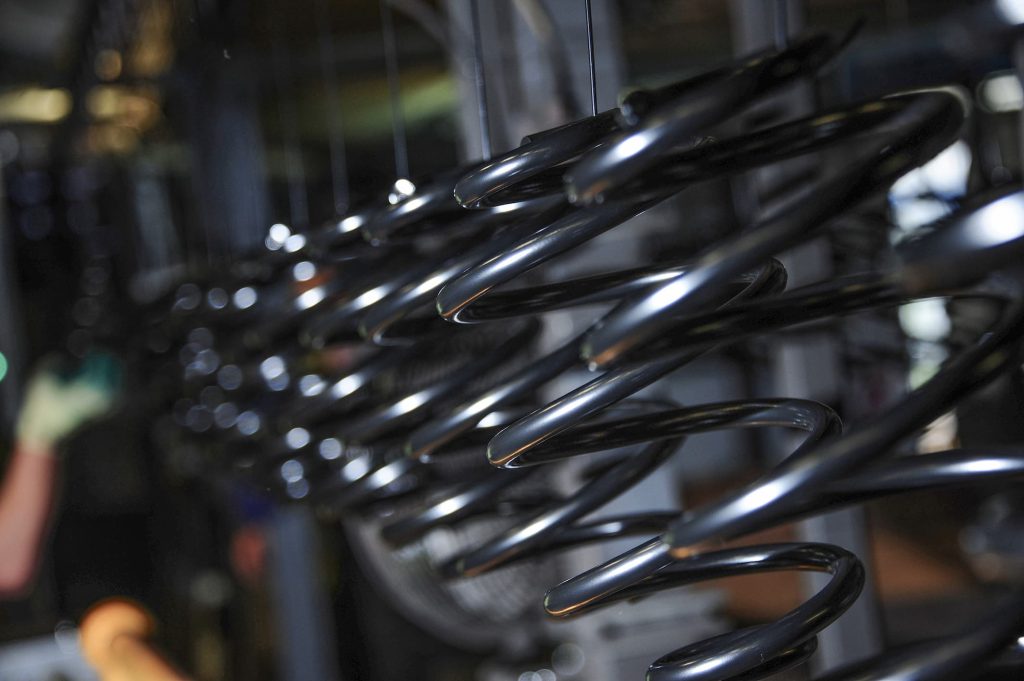Hot or cold coiled from an array of materials across varying wire diameters; the design, material and manufacturing processes are specifically designed for that springs engineered purpose.
With exceptional wire range capabilities from 3mm wire diameter up to 65mm, we utilise hot and cold coiling manufacturing techniques to deliver quality springs across a broad range of industries.
However, how do you work out which one is the best for you?
Compression springs are the most common type of springs, with a unique design meaning that their compressed, helix shape allows them to resist compressive forces, delivering strength and elasticity designed to keep components apart.
They can be manufactured into cylindrical, conical, tapered, convex or concave shapes with a constant or variable pitch, and with either ground or unground ends.
There are a few different types of springs where force increases when axial length decreases, but compression springs (also known as helical springs) are the most common spring type of all.
Common for all is that a wire is formed to a helical shape where coiling radius and pitch can vary with the coil position. The load is introduced into the spring at the end coils, which normally are closed, which means that the pitch angle is reduced as much as possible at the two ends. The ends of the spring are in most cases grinded, which centres the load in the spring and gives a symmetric deflection of the coils.
Most common is the linear, cylindrical compression springs that has a constant coil diameter. The pitch is also, except for the closed end coils, constant. A cylindrical, progressive compression spring is designed with different pitch in different parts of the spring. Conical compression springs are often designed to enable compression to a height equal to the wire diameter. The load-deflection characteristic is normally progressive, but the pitch can be varied to give a close to linear load-deflection relationship. The coil diameter can also be such as giving a barrel or hour-glass shape, which gives properties that can be desired in certain applications.
Spring nests is one way of minimising the required space for the spring function. Two or three compression springs are designed to fit inside each other, meaning that the otherwise empty space inside the spring inner diameter is also used. The coil direction is alternated right-hand and left-hand between the springs.
Circular wire cross-sections dominate, but it can also be square, rectangular, elliptic or other shapes.
The axial deflection of a compression spring gives torsional stresses in the cross section of the wire.
All types of helical compression springs can be theoretically treated with the use of a semi-analytical method, as long as the load is axial. Detailed analysis of other deflection modes requires non-linear FE-analysis
Tension springs (also known as extension springs) are helical coil springs, designed to hold two things together and where force increases with increasing length. From a stress analysis point of view, they are very similar to compression springs. The opposite loading direction does however necessitate some distinguishing features.
The ends of a tension spring need to transmit an extension force. The most common solution of the ends is to bend the wire at the spring ends to a suitable shape. This can be an open hook or a closed loop, it can be placed to centre the force along the spring axis or have it out-of-centre, the height and diameter of the loop can be varied within the limits of manufacturing.
This kind of integrated end in a tension spring often becomes the weakest link in the chain if the spring is used in a dynamic application with many load cycles.
This is due to a stress concentration and an un-favourable residual stress distribution in the bend needed for the hook. For highly dynamic applications, this needs to be considered in the design, but instead of designing the complete spring with the low stress levels needed for the hook to survive, solutions with separate end fittings are often used.
The coils are normally wound tight and with an initial tension force. The spring starts to first deflect when the external force is larger than the initial tension. The initial tension reduces installation length for the spring, compared to a spring without initial tension. Initial tension is not possible in tension springs that are hardened and tempered after coiling. There are also spring requirements that favours a tension spring without initial tension and gaps between the coils.
Torsion springs are coiled springs that work via a twisting, rotational motion, allowing for a flexible object to store mechanical energy when twisted and they are used when there’s a need for angular movement of components. They tend to be stronger and more durable than tension springs.
Torsion springs are used for rotational movements and produce a torque when deflected. In many applications, this torque is used as a force which then equals the torque divided with the lever arm, which is the perpendicular distance between the acting line of the force to the centre of the spring. Some springs that have the shape of a torsion spring might be theoretically better treated as wire forms.
The load is introduced into the spring body through legs, which can have a large variety of shapes. The basic types of the legs are however tangential, radial or axial. Tangential legs are the simplest, where the legs simply follow the tangent at the point where the coiled spring body ends. Radial legs are either radial inwards or radial outwards. Any direction between tangential and radial legs is possible, as are legs bent more than 90°. Multiple bends on the legs are also part of the design, if needed.
As for all torsion springs, the load is ideally introduced into the spring as a torque rather than by a point force. This means that the deflection and stresses are distributed more evenly in the spring material if the legs are fixed. A force coupled on the legs gives better function and lifetime of the spring compared to a single force.
Cold coiled torsion springs have residual stress from the coiling and this gives them a higher elastic limit, if they operate in the up-winding direction compared to the un-winding direction. They are often assembled on a mandrel (although not necessary if the legs are properly fixed) and it must be ensured that the diameter decreases during loading in the up-winding direction, it’s also essential that the mandrel does not limit diameter by providing an obstruction. If this happens, the legs will be the only part of the spring that can deflect and the over-loading that results will lead to spring failure. The same will happen if the axial space is not enough for the increase in length - a result of load in up-winding direction.
The material in a helical torsion spring is stressed during bending. Analytical methods implemented into computer programs are used to predict torque-deflection characteristic and stresses. These methods are based on the assumption that loads are introduced as torque and that the bending stress is symmetrically distributed in the spring. The legs contribute to a large part of the deflection for springs with fewer coils and/or long legs and this must then be accounted for in the calculations.
Knowing there’s an endless shopping list of spring types from bespoke designs to standard off the shelf stock, do dive into the Lesjofors Group spring catalogue to source a standard stock spring and explore our parent companies page on www.lesjoforsab.com to discover every spring for every need. 

